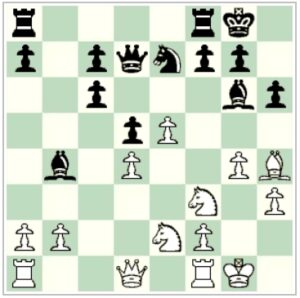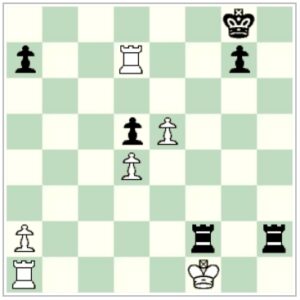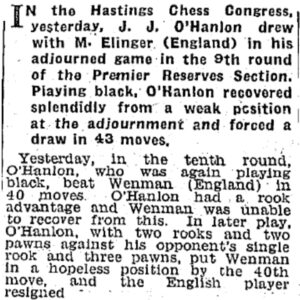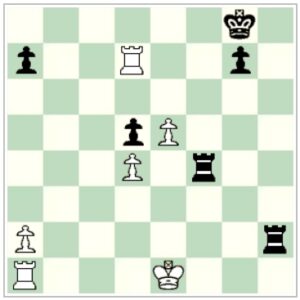Sean has recently posted about a couple of newly rediscovered O’Hanlon games in A Lively Skirmish: O’Hanlon – Scott, British Championship 1921 and O’Hanlon – Seitz, British Championship Major Open B 1938. The nine-time winner of the Irish Championship lost both those games, but there are many O’Hanlon wins to be found in old newspaper columns, some still waiting to be unearthed.
I came across one such win a couple of days ago which (until the date of this post) does not appear to have been available anywhere else. It was played at the 1945-46 Hastings Congress, resuming after an enforced absence due to the Second World War. To mark its local hero returning to international competition the Portadown Times for 29th December 1945 provided this potted biography:
“Mr. J.J. O’Hanlon, the Irish Chess Champion, who is a native of Portadown, and who some years ago sold out his property here and went to reside in Dublin, has left Eire by air, travelling to Hastings to compete with the masters of the game. His prowess as a chess player, together with his swimming feats and skill as an ex-Portadown Club oarsman, have been paid a rare compliment by being featured at length by “Irish Press” and “Irish Independent” columnists. Mr. O’Hanlon’s longest chess game, one writes, took three years. Another states he swam across Carlingford Lough from Greenore to Warrenpoint and right across Lake Geneva. We too, join in wishing him success in his contests at Hastings.”
Francis Percival (Percy) Wenman – John James O’Hanlon
Hastings Premier Reserves C, 1945-46, Round 10
Source: (Dublin) Evening Herald, 26th January 1946, page 4
Annotations by two-time Irish champion James Creevey
1.e4 e5 2.Nf3 Nc6 3.Bb5 Bc5
The classical defence to Ruy Lopez is not often played nowadays and possibly is not as safe as the more usual 3…a6 but Black has his own convictions and the courage of them.
4.c3 Nge7 5.d4 exd4 6.cxd4 Bb4+ 7.Nc3 d5 8.e5
To take or not to take, that is the question. Generally the capture should be made though the advance may be considered when Black’s King’s Knight has been developed on f6. Here 8.exd5 should have been played.
8…0-0 9.Bg5 Bg4
Black’s opening moves are exemplary; already he has gained a move.
10.Bxc6 bxc6 11.0-0 h6 12.Bh4 Qd7 13.h3 Bh5 14.g4
Setting up a target for Black, who soon starts shooting.
14…Bg6 15.Ne2
Moves 14 and 15 were probably played by White under impression the Black’s King’s Bishop could be won. Probably the immediate advance of the Queen’s side pawns (a3, b4) would have been better.
15…h5! 16.Qa4 hxg4
Mark Twain’s couplet fits here:-
“Thrice is he armed that has his quarrel just;
but four times he who gets his blow in first.”
17.Nh2 Nf5 18.Bg3 Nxg3 19.Nxg3 Be7
With two well-posted Bishops against two badly-placed Knights, Black has clearly the better game.
20.hxg4 f5 21.gxf5 Bxf5 22.Rfc1 Rab8! 23.Qxc6 Rxb2 24.Qxd7 Bxd7 25.Nh1 Bh4 26.Rxc7 Bxf2+ 27.Nxf2 Rfxf2 28.Rxd7 Rg2+ 29.Kf1 Rxh2 30.Kg1 Rbg2+ 31.Kf1 Rf2+
32.Ke1
32.Kg1 is also a loss. 32…Rhg2+ 33.Kh1 Rg4 and 34.Rg1 allows mate by 34…Rh4 . In reply to any other defence Black retreats his Queen’s Rook to f5 and mates on the h-file next move.
[There appears to be a flaw in Creevey’s analysis. Instead of the blunder 34.Rg1, White should play 34.Re1 Rf5 35.Re2 defending against the mate and with best play the ending would have been drawn. Indeed, on move 34, moving the Rook anywhere between b1 and d1 also provides access to the second rank, preventing the suggested mate, while pushing the a-pawn forward also achieves the same objective. Therefore we can conclude that 32.Ke1 was the losing blunder]
32…Rf4!!
[Despite Creevey’s two exclamation marks for the final move, there is a more clear-cut (and perhaps more obvious) way to finish off White. The move played will lead to winning the a1-Rook, but instead 32…Rb2 threatens mate which White can only delay but not prevent.]
33. resigns.
Congratulations to Mr. O’Hanlon on his win against a player who has repeatedly won the Scottish championship.
There is a twist in the tale. It appears from the report below (my thanks to Sean for referring me to it) that, contrary to the game score in the Evening Herald, Wenman did not resign immediately after 32…Rf4 and that the game only ended some moves further on.
If we accept that the game did not end with White resigning after Black’s 32nd move, we now need to search for a reconciliation between the differing accounts in the two newspaper articles.
The diagram immediately above shows the final position according to the game score in the Evening Herald. One plausible continuation that works reasonably with the Irish Independent narrative would start with 33.Rxd5
(on 33.Rd1 then Re4+ 34.Kf1 Rh1+ wins the Rook; or 33.Rc1 Re4+ 34.Kd1 Rxd4+ 35.Ke1 Rh1+ again winning the Rook, though in this line there is also the immediately decisive finish of 34…Rg4 when mate with Rg1 is inevitable)
and then after 33…Rh1+ 34.Kd2 (or 34.Ke2) 34…Rxa1 we would arrive at the material imbalance of two Rooks and two pawns versus a single Rook and three pawns mentioned in the Irish Independent article (though my suggested moves seem more compressed than the process described in the Independent).
So instead of ending our game score with “33. resigns”, we could replace it with something like “and White resigned after 40 moves.”
The moral of this story is that if you find a game score, it does not necessarily mean that it tells you the truth, the whole truth and nothing but the truth.




